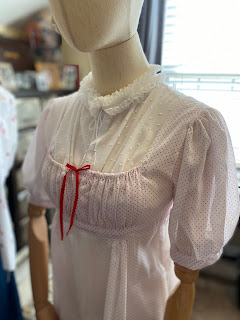With Halloween just around the corner, I couldn't resist revisiting one of my absolute favorite Halloween creations! Although I made this 1920s-inspired fancy dress back in 2022, I had to include it here because it was such a fun project—and perfect for this spooky season. The whole process was full of surprises and fun little DIY wins, so I couldn’t help but share the story behind it!
The Inspiration and Quick Turnaround
"Dyeing" To Pull it all Together
I won’t lie—I was a little nervous about dyeing the fabric for this project. The main fabric had glow-in-the-dark pumpkins, and I wasn’t sure how they’d take the dye. Plus, my dyeing experience was limited to a single hat years ago, so I wasn’t exactly a pro. Well as I am prone to do, I didn't waste time thinking about it, I just tossed the fabric into the "tangerine" dye and crossed my fingers!
After dyeing the pumpkin fabric, I noticed that the orange in my diamond-patterned fabric looked a bit muted by comparison. So, I gave it a quick dip in some tangerine dye—just five minutes was all it needed. The colors came out beautifully, and everything was finally in harmony.
Bringing the Dress to Life
For the dress itself, I started with an authentic 1920s pattern (New Butterick 1376) adding a few tweaks here and there to fit my overall look. The original design featured scalloped trim along the bodice and skirt, but I opted for a cleaner, simpler look. I scooped out the neckline and widened the armholes slightly to capture that easy, elegant 1920s silhouette. The skirt was a simple gathered rectangle.
The real star was the fabric! I used the most incredible crushed velvet for the skirt. It was synthetic but felt and looked just like a vintage silk velvet fabric! (So, of course, I had to run back out to JoAnns and buy up the rest of it in orange and green for future projects. I mean we all do this, right?!) Every time I walked the fabric had that perfect 1920s swish. It really gave the dress so much character!
Finishing Touches
The waistband was totally a last-minute stroke of luck! (Remember, I was working on a tight timeline, so “perfectly authentic” materials weren’t happening.) I grabbed the very last bit of rusty orange netting at Joann’s and loved how it pulled everything together. I even had just enough left to whip up a matching headband—wrapped around a paper plate for structure, of course, because DIY is all about getting creative!
No 1920s look is complete without a bob, so I gave myself a faux bob, piled on some smoky eye makeup, and topped it off with red lipstick for that classic 1920s flair. The result? A look that was both vintage and Halloween-ready!
Reflecting on My 2022 Creation
Photographing this dress was an absolute joy—especially because I stepped in front of the camera for once! Normally, I’m behind the scenes, because being in front is honestly out of my comfort zone. But if I can be silly then I'm game. Usually the silliness turns out complete garbage, but this was just me and my camera and it was a fun time! (Watch the silly video here.)
This 1920s Halloween dress was one of my favorite creations from 2022, and I hope I get the chance to wear it to an event someday. If you want to see more behind-the-scenes details or my creative process, check out my Instagram highlights and reels. I had so much fun with this project, and I’d love to hear your thoughts in the comments!
Here’s to another year of vintage-inspired Halloween creations! 🎃🧡
#1920sHalloween #VintageHalloween #BeespokeVintage #1920sFashion #HandmadeWithJoann #VintageStyle #SewingCommunity #VintagePatterns #1920sDress



























































